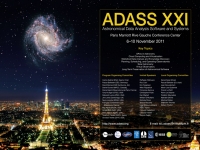Fabio Pasian (INAF - O.A.Trieste), A. Zacchei (INAF-OATs), F.Pasian (INAF-OATs) et al.
Abstract
Planck is an ESA mission launched in May 2009, which is mapping the microwave sky in nine frequencies and accurately measuring the anisotropies of the Cosmic Microwave Background (CMB) with its complement of two instruments.
The operations and data processing of its Low-Frequency Instrument are carried out by a Data Processing Centre. The LFI DPC has been designed to be a centralized facility built by geographically distributed institutions, in a funding scenario based on multiple funding agencies and, in most cases, on fixed budget in the presence of launch delays. The LFI DPC needs to support both a day-by-day quasi-real-time workflow and high-throughput pipelines for a high-volume data flow.
A strategy for managing effectively the geographically distributed and collaborative software development and maintenance has been developed, based on the use of open source and COTS software, and on the reuse of systems developed ad-hoc for other missions. Product and quality assurance has been supported throughout development, integration and testing.
The effectiveness of the design choices has been proven by the readiness of the system and the extremely smooth operations phase. Some lessons learned are discussed.
Paper ID: P111
Poster Instructions
|

